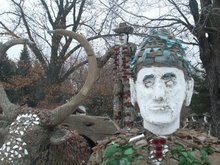In 1964, the Company performed construction management services on a dam we had designed upstream of Monrovia in Liberia at a site called Mount Coffee. We originally constructed a long main dam, a forebay dam, an interconnecting channel, tailrace, intakes, powerhouse and two hydroelectric turbines to harness part of the energy tumbling down the St. Paul River. Soon thereafter, a European outfit added two more turbines in an extended power house. With four turbines in operation, the facility produced a nominal 65 megawatts of power for the next thirty years, until…
Instability in Liberia took its toll on Liberian infrastructure. As the story goes, one day in October, 1991, the dam operators were prohibited from reporting to work by one of the various factions fighting for control of the country. They weren’t there at a critical time during the rainy season to open the large tainter gates on the main dam and let the swollen river pass through. Instead, the reservoir filled to overtopping, then overtopped the dam.
What happened next must have both frightened and thrilled anyone lucky enough to witness the breech of 400 meters of earthen dam, and the immediate draining of the 30 meters of water stored behind it. The flood changed the course of the river, but also changed the course of the country, because there was no replacement facility for the power that Mt. Coffee produced, and even now, the government capacity in Monrovia is a scant 15 megawatts, barely a fourth of what they had before the failure.
At that time, the only real damage was to the forebay dam, which could be repaired without too much delay. However, the situation of the civil war didn’t allow the safety or economic conditions that were needed to have been in place for reconstruction. Instead, insult was heaped upon injury, as a very organized group of looters worked their particular form of dark magic on the power plant.
They took everything except the concrete and the tainter gates on the main dam, and some embedded parts that would be too difficult to cut up and sell for scrap. They took wires and lights and siding. They took the control room hardware and cranes and turbines. They took the motors that used to open the tainter gates, and they took the towers and transmission lines that used to convey electricity to the coast. All that remains today is an empty concrete shell, and we are working to fit a new power plant inside it, one that will generate up to 100 megawatts of power, as turbine efficiency has improved over the past half century.
But first, we need to make sure that there was no significant damage to the pieces we want to reuse. During this field exercise, we are examining the damage caused by the escaping water along the floodpath, we are examining the dam embankments for subtle signs of failure, we are making sure that the turbine pits are still round and vertical, and we’re examining the submerged portions of the powerhouse to make sure that it wasn’t scoured by the flood.
It’s great fun.
2012-01-08
Mount Coffee
Subscribe to:
Post Comments (Atom)




No comments:
Post a Comment